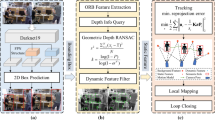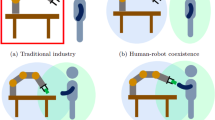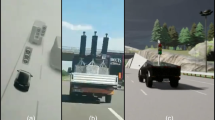Abstract
Modeling an open environment that contains unpredictable objects is a challenging problem in the field of robotics. In traditional approaches, when a robot encounters an unknown object, a mistake will inevitably be added to the robot’s environmental model, severely constraining the robot’s autonomy, and possibly leading to disastrous consequences in certain settings. The abundant knowledge accumulated on the Internet has the potential to remedy the uncertainties that result from encountering with unknown objects. However, robotic applications generally pay considerable attention to quality of service (QoS). For this reason, directly accessing the Internet, which can be unpredictable, is generally not acceptable. RoboCloud is proposed as a novel approach to environment modeling that takes advantage of the Internet without sacrificing the critical properties of QoS. RoboCloud is a “mission cloud–public cloud” layered cloud organization model in which the mission cloud provides QoS-available environment modeling capability with built-in prior knowledge while the public cloud is the existing services provided by the Internet. The “cloud phase transition” mechanism seeks help from the public cloud only when a request is outside the knowledge of the mission cloud and the QoS cost is acceptable. We have adopted semantic mapping, a typical robotic environment modeling task, to illustrate and substantiate our approach and key mechanism. Experiments using open 2D and 3D datasets with real robots have demonstrated that RoboCloud is able to augment robotic visions for open environment modeling.
Similar content being viewed by others
References
Nüchter A, Hertzberg J. Towards semantic maps for mobile robots. Robot Auton Syst, 2008, 56: 915–926
Wolf D F, Sukhatme G S. Semantic mapping using mobile robots. IEEE Trans Robot, 2008, 24: 245–258
Fulcher J. Computational Intelligence: An Introduction. Berlin: Springer, 2008
Kehoe B, Patil S, Abbeel P, et al. A survey of research on cloud robotics and automation. IEEE Trans Autom Sci Eng, 2015, 12: 398–409
Riazuelo L, Tenorth M, Marco D D, et al. RoboEarth semantic mapping: a cloud enabled knowledge-based approach. IEEE Trans Autom Sci Eng, 2015, 12: 432–443
Satyanarayanan M, Bahl P, Caceres R, et al. The case for VM-based cloudlets in mobile computing. IEEE Pervas Comput, 2009, 8: 14–23
Furrer J, Kamei K, Sharma C, et al. Unr-pf: an open-source platform for cloud networked robotic services. In: Proceedings of IEEE/SICE International Symposium on System Integration, Fukuoka, 2012
Kostavelis I, Gasteratos A. Semantic mapping for mobile robotics tasks: a survey. Robot Auton Syst, 2015, 66: 86–103
Durrant-Whyte H, Bailey T. Simultaneous localization and mapping: part I. IEEE Robot Autom Mag, 2006, 13: 99–110
Mohanarajah G, Hunziker D, D’Andrea R, et al. Rapyuta: a cloud robotics platform. IEEE Trans Autom Sci Eng, 2015, 12: 481–493
Ashutosh S, Ashesh J, Ozan S, et al. Robobrain: large-scale knowledge engine for robots. 2014. ArXiv:1412.0691
Qureshi B, Javed Y, Koubâa A, et al. Performance of a low cost Hadoop cluster for image analysis in cloud robotics environment. Procedia Comput Sci, 2016, 82: 90–98
Ren S Q, He K M, Girshick R, et al. Faster R-CNN: towards real-time object detection with region proposal networks. IEEE Trans Pattern Anal Mach Intel, 2017, 39: 1137–1149
Beksi W J, Spruth J, Papanikolopoulos N. Core: a cloud-based object recognition engine for robotics. In: Proceedings of IEEE/RSJ International Conference on Intelligent Robots and Systems, Hamburg, 2015
Szegedy C, Toshev A, Erhan D. Deep neural networks for object detection. Adv Neural Inf Process Syst, 2013, 26: 2553–2561
Girshick R, Donahue J, Darrell T, et al. Rich feature hierarchies for accurate object detection and semantic segmentation. 2014. ArXiv:1311.2524
Girshick R. Fast R-CNN. 2015. ArXiv:1504.08083
Everingham M, Van Gool L, Williams C K I, et al. The pascal visual object classes (VOC) challenge. Int J Comput Vis, 2010, 88: 303–338
Torralba A, Murphy K P, Freeman W T. Shared features for multiclass object detection. In: Toward Category-Level Object Recognition. Berlin: Springer, 2006. 345–361
Li Y Y, Wang H M, Ding B, et al. Learning from internet: handling uncertainty in robotic environment modeling. In: Proceedings of the 9th Asia-Pacific Symposium on Internetware, Shanghai, 2017
Duan K B, Keerthi S. Which is the best multiclass svm method? an empirical study. In: Proceedings of International Workshop on Multiple Classifier Systems, Seaside, 2005. 278–285
Li Y Y, Wang H M, Ding B, et al. Toward qos-aware cloud robotic applications: a hybrid architecture and its implementation. In: Proceedings of IEEE Conferences on Ubiquitous Intelligence and Computing, Advanced and Trusted Computing, Scalable Computing and Communications, Cloud and Big Data Computing, Internet of People, and Smart World Congress, Toulouse, 2017
Acknowledgements
This work was partially supported by National Natural Science Foundation of China (Grant Nos. 91118008, 61202117, 61772030), Special Program for the Applied Basic Research of National University of Defense Technology (Grant No. ZDYYJCYJ20140601), and Jiangsu Future Networks Innovation Institute Prospective Research Project on Future Networks (Grant No. BY2013095-2-08).
Author information
Authors and Affiliations
Corresponding author
Rights and permissions
About this article
Cite this article
Li, Y., Wang, H., Ding, B. et al. RoboCloud: augmenting robotic visions for open environment modeling using Internet knowledge. Sci. China Inf. Sci. 61, 050102 (2018). https://doi.org/10.1007/s11432-017-9380-5
Received:
Revised:
Accepted:
Published:
DOI: https://doi.org/10.1007/s11432-017-9380-5




